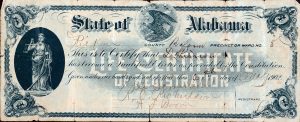This post features a “Lifetime” voter-registration certificate recently discovered in a local antiques mall. It is an attractive and oddly cheerful bit of ephemera from a tragic era in Alabama history–the time of mass disfranchisement by means of the state’s 1901 constitution. Pondering the significance of the certificate, only slightly larger than a 19th-century dollar bill, led to the following thoughts.
Alabama’s 1901 Constitution: Instrument of Power
In the late 1890s, after overcoming serious challenges to their power, Alabama Democratic politicians decided to take decisive action. They had used various illegal tactics—chiefly ballot-box stuffing—to defeat “fusionist” coalitions of agrarians, Populists, and Republicans. They had won the elections; they remained in power. But in the process their exercise of power had lost any claim to a basis in morality. In order to prevent future challenges (and to shield themselves from the temptation to cheat), they decided to follow a plan first carried out in Mississippi in 1890 and since perfected in other southern states. The plan’s chief feature was the adoption of a new constitution, one whose voter registration provisions would disfranchise large numbers of citizens. African American voters were the primary targets; but significant numbers of hill country white voters were likewise vulnerable. The Democrats justified disfranchisement on the grounds that it would “purify” politics by eliminating unworthy voters—surely one of our most striking examples of blaming the victims. If any further excuse were needed, the Democrats, especially the “Bourbons” of Alabama’s Black Belt counties, claimed that a new constitution would maintain “White Supremacy.” This last argument, it should be noted, was exactly how they had justified ballot box stuffing. After one or two false starts, the disfranchisers engineered a constitutional convention to meet in Montgomery in the late summer of 1901.
The disfranchisers didn’t shy away from making their chief motives crystal-clear. Consider the following quotes taken from convention president John B. Knox’s opening address.
“And what is it that we want to do? Why, it is, within the limits imposed by the Federal Constitution, to establish white supremacy in this State.” [Journal of the Proceedings of the Constitutional Convention (1901), 9.]
“But if we would have white supremacy, we must establish it by law—not by force or fraud. If you teach your boy that it is right to buy a vote, it is an easy step for him to learn to use money to bribe or corrupt officials or trustees of any class. If you teach your boy that it is right to steal votes, it is an easy step for him to believe that it is right to steal whatever he may need or greatly desire. The results of such an influence will enter every branch of society; it will reach your bank cashiers, and affect positions of trust in every department; it will ultimately enter your courts, and affect the administration of justice.” [Journal of the Proceedings of the Constitutional Convention (1901), 12.]
The Democratic majority at the 1901 convention proceeded to adopt two voter registration plans, a “temporary plan” in effect through December 20, 1902, and a “permanent” plan to be used from January 1903 on.
The Temporary Plan (1901 Const., Art. 8, §180) was put in place in order to placate white voters from North Alabama; its chief feature was the “fighting grandfather” clause, by which the adult (age 21) male descendants of Confederate soldiers could register to vote. The section likewise allowed the registrars to enroll “All persons who are of good character and who understand the duties and obligations of citizenship under a republican form of government.”
Under the Temporary Plan, registration was to be carried out by three-man county boards of registrars, each to be chosen by the governor, acting with the commissioner of agriculture and the state auditor (Art. 8, §186).
Lifetime Registration (Art. 8, §187). By February 1, 1903, the boards of registrars were to file in their respective offices of Probate, lists of those persons registered. Each person who registered on or before January 1, 1903, unless he subsequently became disqualified, “shall remain an elector during life, and shall not be required to register again unless he changes his residence, in which event he may register again on production of his certificate.”
See the image of one such certificate, issued to D. Pierson, of Reform Beat, Pickens County, on May 6, 1902.
The Permanent Plan required would-be voters to:
–be 21 years old and male (Art. 8, §177);
–be a resident in state for 2 years (with lesser residence requirements for voting in county and municipal elections) (Art. 8, §178);
–have paid all poll taxes from 1901 onward (Art. 8, §178);
–be able to read and write any article of the U.S. Constitution, and have been gainfully employed for the previous 12 months (with exemptions for persons whose illiteracy or unemployment was due to physical disabilities) (Art. 8, §181), or
–be the owner of 40 acres of land or other property valued at $300 or more, on which the taxes have been paid (with exemptions for men whose wives meet the property requirement).

The Permanent Plan also barred from voting (Art. 8, §182) any persons who have been convicted of any of a list of more than 20 crimes, including “any crime punishable by imprisonment in the penitentiary.” Likewise anyone “convicted as a vagrant or tramp” and any person “offering to sell his vote or the vote of another” or “of buying or offering to buy the vote of another.”
Under Art. 8, §183, no person could vote in a primary election without being officially registered to vote.
The ratification election for the 1901 Constitution was held on November 11, 1901. The official vote was 108,613 (in favor) to 81,734 (against).
Twelve Black Belt counties voted in favor of the constitution by a vote of 36,224 to 5,471. The “vote in the other fifty-four counties of the state was 76,263 against to 72,389 for the constitution.” See Malcolm C. McMillan, Constitutional Development in Alabama (Chapel Hill, NC: James Sprunt Studies, 1955), 350. McMillan also notes a report (Mobile Register, November 13, 1901) that the Black Belt counties were slow in reporting their votes—an old tactic by which Black Belt political bosses could determine how many votes they “needed” to count. Thus on the face of the official returns, we are expected to believe that a considerable majority of African American voters voted to disfranchise themselves.
In the years following adoption, African American voting almost vanished and white voting declined. The late Sheldon Hackney calculated that 35 per cent of potential white voters were “disfranchised by the poll tax alone.” He concluded ironically that “The convention had done its job well.” See Hackney, Populism to Progressivism in Alabama (Princeton, NJ: Princeton University Press, 1969), 208.
In addition to McMillan and Hackney, interested readers may consult the following works:
Glenn Feldman, The Disfranchisement Myth: Poor Whites and Suffrage Restriction in Alabama (Athens, Georgia: University of Georgia Press, 2004).
R. Volney Riser, Defying Disfranchisement: Black Voting Rights Activism in the Jim Crow South, 1890-1908 (Baton Rouge: Louisiana State University Press, 2010).
William Warren Rogers, The One-Gallused Rebellion: Agrarianism in Alabama, 1865-1896 (Baton Rouge: Louisiana State University Press, 1970; subsequent edition, University of Alabama Press, 2001).
William Warren Rogers, et al., Alabama: The History of a Deep South State (Tuscaloosa, University of Alabama Press, 1994; subsequent edition, 2010).
Bailey Thomson, ed., A Century of Controversy: Constitutional Reform in Alabama (Tuscaloosa: University of Alabama Press, 2002).
Samuel Webb, Two-Party Politics in the One-Party South: Alabama’s Hill Country, 1874-1920 (Tuscaloosa: University of Alabama Press, 1997).
